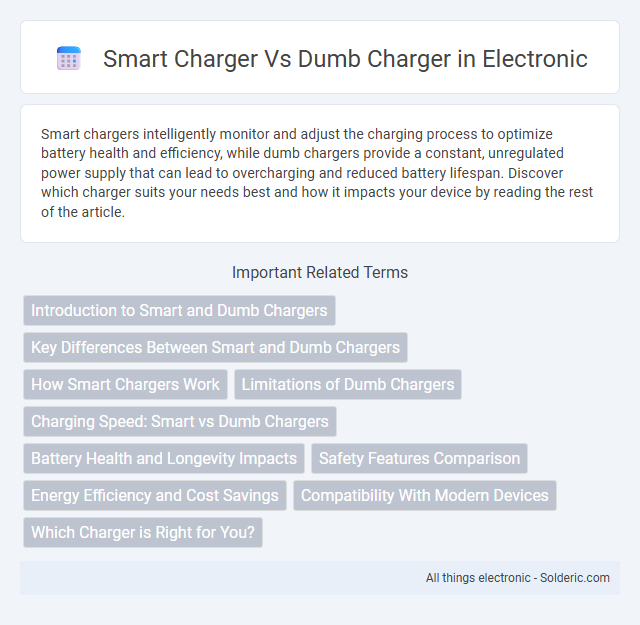Smart chargers intelligently monitor and adjust the charging process to optimize battery health and efficiency, while dumb chargers provide a constant, unregulated power supply that can lead to overcharging and reduced battery lifespan. Discover which charger suits your needs best and how it impacts your device by reading the rest of the article.
Comparison Table
| Feature | Smart Charger | Dumb Charger |
|---|---|---|
| Charging Control | Automatic adjustment based on battery status | Constant current, no adjustment |
| Battery Protection | Prevents overcharging and overheating | No protection, risk of damage |
| Charging Speed | Optimized for fast and safe charging | Fixed speed, often slower |
| Compatibility | Supports multiple battery types and chemistries | Limited compatibility |
| Cost | Higher initial investment | Lower cost |
| User Interface | LCD display or indicators with real-time info | Simple LED or none |
| Energy Efficiency | High efficiency, less power waste | Lower efficiency |
| Smart Features | Connectivity, app control, diagnostics | None |
Introduction to Smart and Dumb Chargers
Smart chargers feature advanced technology that monitors battery health and adjusts charging rates to optimize performance and extend battery life, while dumb chargers provide a constant, unregulated voltage or current without feedback mechanisms. Your choice between a smart charger and a dumb charger impacts charging efficiency, safety, and battery longevity. Understanding these differences is crucial for ensuring reliable power management in devices and vehicles.
Key Differences Between Smart and Dumb Chargers
Smart chargers feature intelligent technology that adjusts charging current based on battery condition, preventing overcharging and extending battery lifespan. Dumb chargers provide a constant, unregulated charge, which can lead to overheating and reduced battery performance. Choosing the right charger influences your device's battery health and overall efficiency.
How Smart Chargers Work
Smart chargers use microprocessor-controlled circuits to monitor battery voltage, temperature, and charge current in real-time, adjusting the charging process accordingly. They implement multiple charging stages, such as bulk, absorption, and float, to optimize battery health and extend lifespan. These chargers prevent overcharging and overheating by automatically reducing current or switching to trickle charge mode once the battery is near full capacity.
Limitations of Dumb Chargers
Dumb chargers lack the ability to monitor battery status, leading to potential overcharging and reduced battery lifespan. They provide a constant charge without adjusting voltage or current based on battery needs, causing inefficiencies and safety hazards. This limitation results in slower charging times and increased risk of battery damage compared to smart chargers.
Charging Speed: Smart vs Dumb Chargers
Smart chargers optimize charging speed by adjusting current flow based on battery type and condition, preventing overcharging and enhancing efficiency. Dumb chargers provide a constant current regardless of battery status, often resulting in slower charging times and potential battery damage. The intelligent modulation of smart chargers ensures faster, safer, and more reliable energy transfer compared to traditional dumb chargers.
Battery Health and Longevity Impacts
Smart chargers optimize battery health by regulating voltage and current, preventing overcharging and overheating, which significantly extends battery longevity. Dumb chargers lack these adaptive features, often delivering a constant charge that can cause battery degradation, reduced capacity, and shorter lifespan. Investing in a smart charger promotes consistent battery performance and durability, especially for lithium-ion and lead-acid batteries.
Safety Features Comparison
Smart chargers incorporate advanced safety features such as overcharge protection, temperature monitoring, and automatic shutoff to prevent battery damage and ensure optimal charging performance. Dumb chargers lack these intelligent controls, increasing the risk of overheating, overcharging, and potential battery failure. Choosing a smart charger enhances your device's safety by reducing hazards commonly associated with basic charging technology.
Energy Efficiency and Cost Savings
Smart chargers optimize energy efficiency by adjusting the charging current based on your device's battery status, preventing overcharging and reducing electricity consumption compared to dumb chargers that deliver a constant charge. This intelligent regulation extends battery lifespan, lowering replacement costs and saving money over time. Choosing a smart charger translates into significant cost savings through decreased energy use and reduced need for frequent battery replacements.
Compatibility With Modern Devices
Smart chargers excel in compatibility with modern devices by intelligently adjusting voltage and current based on the device's requirements, ensuring safe and efficient charging. Dumb chargers provide a fixed output, which may lead to slower charging speeds and potential damage to sensitive electronics. As a result, smart chargers better support fast-charging protocols and protect battery health across a wide range of smartphones, tablets, and laptops.
Which Charger is Right for You?
Choosing between a smart charger and a dumb charger depends on your charging needs and device compatibility. Smart chargers offer advanced features like automatic voltage adjustment, battery health monitoring, and faster charging, making them ideal for modern devices and prolonged battery life. If you need a straightforward, low-cost solution for simple, less-sensitive batteries, a dumb charger may suffice, but your devices will benefit most from the precision and protection of a smart charger.
Smart charger vs Dumb charger Infographic

 solderic.com
solderic.com